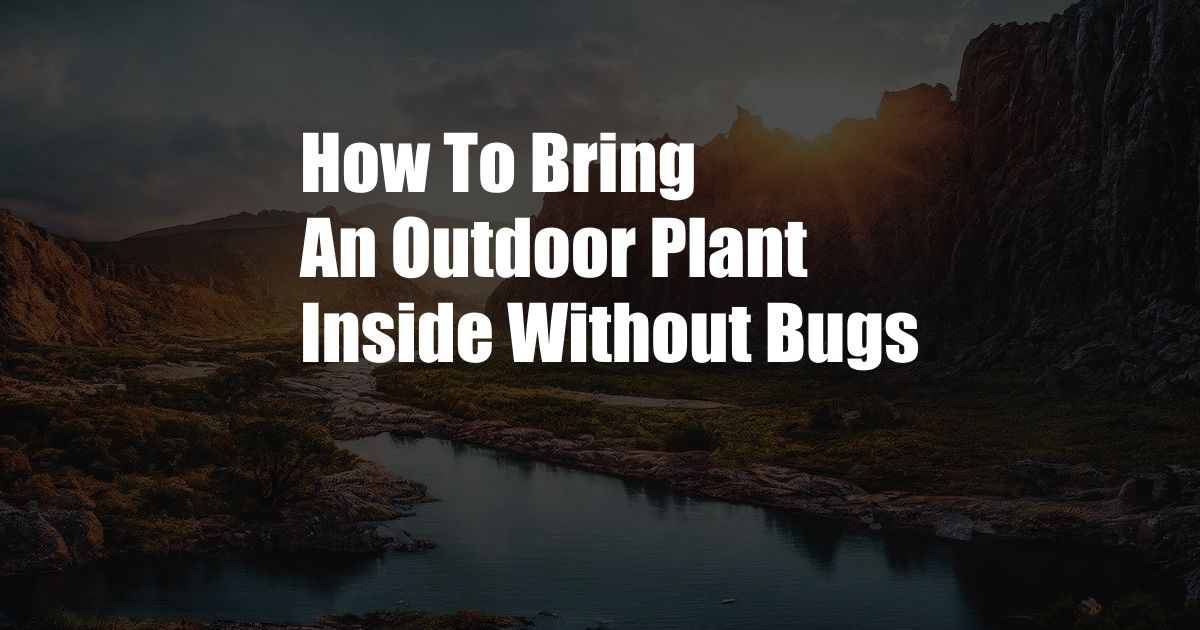
How to Bring an Outdoor Plant Inside Without Bugs
Bringing your beloved outdoor plants inside as the cold weather approaches can be a daunting task, especially if you’re concerned about introducing unwanted guests into your home. Bugs, mites, and other pests can hitch a ride on your plants, causing potential damage to both your indoor ecosystem and the plants themselves.
To ensure a smooth transition, it’s crucial to take precautionary measures to effectively remove any lurking bugs. This article will provide a comprehensive guide to help you bring your outdoor plants indoors bug-free, ensuring a healthy and thriving indoor oasis throughout the winter months.
Identifying Potential Pests
Before bringing your outdoor plants inside, it’s essential to inspect them thoroughly for any signs of pests. Check the undersides of leaves, stems, and soil for:
- Small, moving insects
- Tiny white or brown specks (eggs or larvae)
- Chewed or damaged leaves
- Webbing or sticky residue
Identifying the type of pest is crucial to determine the most effective treatment. Common pests include aphids, mealybugs, spider mites, and whiteflies.
Natural Pest Removal Methods
If you discover pests on your plants, there are several natural methods you can employ to eliminate them before bringing them indoors:
- Neem Oil: A natural insecticide that effectively kills pests without harming the plant.
- Soapy Water Spray: A mixture of insecticidal soap and water can suffocate and kill soft-bodied pests like aphids and spider mites.
- Manual Removal: Physically pick off visible pests with your fingers or use a cotton swab dipped in alcohol to remove eggs and larvae.
Always follow the manufacturer’s instructions when using commercial pest control products. If natural methods prove unsuccessful, consider consulting a professional pest control company.
Prepping the Plants
Once you’ve eliminated any pests, it’s time to prepare your plants for their indoor relocation. To prevent future infestations, consider the following steps:
- Thoroughly Rinse: Use a hose or showerhead to rinse the entire plant, including the leaves, stems, and soil, to remove any remaining pests or eggs.
- Prune Infected Leaves: If any leaves are severely damaged or harboring pests, remove them to prevent further spread.
- Isolate Suspicious Plants: If you suspect a plant has been heavily infested, isolate it from other plants and observe it closely for signs of re-infestation.
- Maintain Plant Health: Healthy plants are less susceptible to pests. Provide adequate light, water, and nutrients.
- Quarantine New Plants: Isolate newly purchased plants for a few weeks before introducing them to your existing indoor collection.
- Use Companion Planting: Certain plants, such as marigolds and basil, can repel pests.
Monitoring and Prevention
Once your plants are indoors, it’s essential to continue monitoring for pests. Regularly inspect the leaves and soil, and isolate any newly infested plants promptly. To prevent future infestations:
FAQs
Q: How long should I isolate a plant that has been infested?
A: Isolate the plant for at least two weeks, or until you’re confident that the infestation has been controlled.
Q: Can I use chemical insecticides indoors?
A: While chemical insecticides can be effective, it’s generally not recommended to use them indoors due to potential health and environmental concerns. Always follow the manufacturer’s instructions carefully.
Q: How often should I inspect my indoor plants for pests?
A: Inspect your plants weekly for signs of pests. Pay special attention to newly acquired plants and those that have been exposed to outdoor conditions.
By following these tips and expert advice, you can successfully bring your outdoor plants indoors without introducing unwanted pests. Enjoy the beauty and benefits of your indoor oasis throughout the cold weather months.
Are you interested in learning more about pest control and indoor plant care? Explore our website for more informative articles and resources.